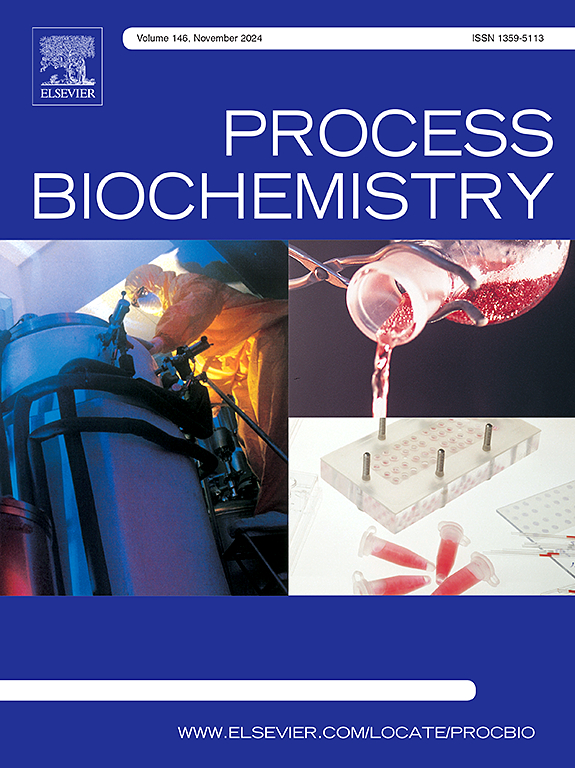The start-up of red blood cell-like Anammox granular sludge based on substrate volume flux
IF 3.7
3区 生物学
Q2 BIOCHEMISTRY & MOLECULAR BIOLOGY
引用次数: 0
Abstract
Enhancing substrate transfer is crucial for promoting the nitrogen removal rate of Anammox granular sludge, as the shape of the granules significantly influences substrate diffusion. In this study, inspired by biomimicry principles, we propose a novel red blood cell-like granular sludge to increase the contact area and improve substrate transfer. The startup and operation of Anammox granular sludge in low-strength ammonia nitrogen wastewater were successfully achieved through an increase in substrate volume flux (SVF). As the SVF increased from 2.38 to 7.43 L²/(g VSS·h), specific Anammox activity (SAA) rose from 0.138 to 0.483 g N/(g VSS·d). The Anammox granular sludge system achieved a total nitrogen removal efficiency of 85.70 % and a nitrogen removal rate (NRR) of 0.792 kg N/(m³·d) after 126 days. Notably, red blood cell-like granular sludge was observed by day 116. The rise in SVF induced a granule structure more conducive to substrate transport, improving the granules' efficiency in substrate uptake and thereby enhancing their SAA. High-throughput pyrosequencing revealed that the dominant bacteria using the SVF-enhancing strategy remained anaerobic ammonium oxidizing bacteria (AnAOB) (29.53 %-29.89 %), with an increased diversity of species, including Candidatus Kuenenia, Candidatus Anammoxoglobus, and Candidatus Brocadia.
基于底物体积通量的红细胞样厌氧氨氧化颗粒污泥的启动
增强底物转移对于提高厌氧氨氧化颗粒污泥的氮去除率至关重要,因为颗粒的形状会显著影响底物的扩散。在这项研究中,受仿生学原理的启发,我们提出了一种新的红细胞样颗粒污泥,以增加接触面积并改善基质转移。通过提高基质体积通量(SVF),成功实现了低强度氨氮废水中厌氧氨氧化颗粒污泥的启动和运行。当SVF由2.38增加到7.43 L²/(g VSS·h)时,特定厌氧氨氧化活性(SAA)由0.138增加到0.483 g N/(g VSS·d)。厌氧氨氧化颗粒污泥系统运行126天后,总氮去除率为85.70 %,氮去除率(NRR)为0.792 kg N/(m³·d)。值得注意的是,第116天观察到红细胞样颗粒污泥。SVF的升高导致颗粒结构更有利于底物运输,提高颗粒对底物的吸收效率,从而提高其SAA。高通量焦磷酸测序显示,使用svf增强策略的优势菌仍然是厌氧氨氧化菌(AnAOB)(29.53 %-29.89 %),物种多样性增加,包括Candidatus Kuenenia, Candidatus Anammoxoglobus和Candidatus Brocadia。
本文章由计算机程序翻译,如有差异,请以英文原文为准。
求助全文
约1分钟内获得全文
求助全文
来源期刊

Process Biochemistry
生物-工程:化工
CiteScore
8.30
自引率
4.50%
发文量
374
审稿时长
53 days
期刊介绍:
Process Biochemistry is an application-orientated research journal devoted to reporting advances with originality and novelty, in the science and technology of the processes involving bioactive molecules and living organisms. These processes concern the production of useful metabolites or materials, or the removal of toxic compounds using tools and methods of current biology and engineering. Its main areas of interest include novel bioprocesses and enabling technologies (such as nanobiotechnology, tissue engineering, directed evolution, metabolic engineering, systems biology, and synthetic biology) applicable in food (nutraceutical), healthcare (medical, pharmaceutical, cosmetic), energy (biofuels), environmental, and biorefinery industries and their underlying biological and engineering principles.
 求助内容:
求助内容: 应助结果提醒方式:
应助结果提醒方式:


